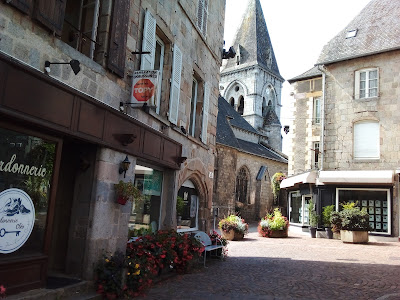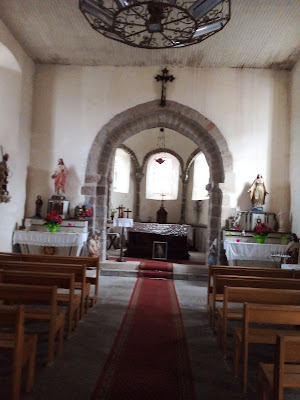The countryside of Correze reminds me of western New York - or maybe it's the other way round as France came first. Hills and forests and farms. But there's one thing that Cattaraugus County doesn't have..
One of the beauties of Correze is its old stone. Every little village has its ancient church, like this one at St Hilaire-Luc
Some date from the 12th century or before. In those days you didn't travel far from your village. Even when I started coming here a few decades ago, most of the villages would still have Mass on Sundays. Not so now. But every old church is a gem. And every village has its quaint corners.Cottages with climbing roses..
A ricketty gate - or an artwork?
The war memorial surrounded by flowers
And every war memorial has its poignant list of names, mostly from the First World War. And every time I see one I'm humbled anew by so many lives lost from such a tiny place. Many with the same family names.
St Hilaire-Luc is a little visitor-conscious though. A new type of person now comes to Correze and the back-to-the-landers, second homers love memorabilia. This is the back garden of the antique shop. They'd probably want an arm and a leg for that metal bucket.
In a discreet way tourism has arrived here.
A few miles away is the town of Ussel - our local metropolis, home of the college, the hospital, the big Leclerc supermarket, the swimming pool. While hubby went swimming, I explored a town I'd only usually gone to for necessities. I'd forgotten what a gem it is, even though the snooty guidebooks consider it pretty run-of-the-mill. Trouble is, there's just so much of this in France. You're spoilt for choice. This looked intriguing
And very fittingly led to a small shrine on the wall.
What stories these old alleys could tell.
And St Martin's Church, now the local hub, with only four priests serving a vast mission parish of outlying villages. And two of those have come from Africa.
One year I went to a big bash in this square, honouring devotees of tete de veau (see below!), robing them in academic gowns and presenting them with spoof diplomas. They cooked the gloopy gunk in a huge cauldron and people sat at long tables enjoying the feast. That arch with the flower arrangement is always lovely.
The little water fountains are typical too.
This is Ussel's most famous house - once owned by the Dukes of Ventadour as their town home. They had a big sprawling castle out in the countryside and had a lot of trendy troubadour connections back in the day. The friendly book shop owner said it's not open to the public - even though it features in all the tourist brochures. He was excited to see us - he said he had relatives in Charleston, South Carolina. And the bookshop was spectacular.
One Sunday we went to Mass at the Cathedral in Tulle, Correze's administrative centre, deep in the river valley. Again it's a town that isn't an obvious tourist spot but still worth exploring.
With some grand town houses - some now being restored
And more narrow cobbled streets.
On Sunday it was deserted, with only one restaurant obviously open. Easy to think yourself back into the Middle Ages - without the noise and smells.
Back to Ussel again and here's the little chapel of Notre Dame de la Chabanne, looking like one of those old German spiked helmets.
The interior is glorious.
A few years ago we came here for the 8th September Nativity of the Virgin Mary feast. It was packed to the rafters, people singing lustily, "Notre Dam-e de la Chabann-e," We joined in, worrying about our Florida house in the throes of Hurricane Irma. And she came through for us. This year the chapel was much less full. Was it that so many people didn't go back after Covid? Or perhaps it was the rival procession in Eygurande, which also has a lovely shrine. Sadly, when we explored around there, I left my phone at home, so no photos.
We happened to be in Ussel for Patrimony Days, a European Union thing - where various places not normally open to the public let the tourists in. The Ventadour house wasn't on the list. But the Penitents' Chapel was.
It's now a museum but on this weekend we could get in free.
A horse pulling a hearse. Magnificently morbid.
Across town in the other museum I was fascinated by these wall beds - a feature of some of the local old houses. Each was exquisitely carved and decorated with different patterned curtains. Though you'd have to have been pretty short to be comfortable in them. I only noticed the chamber pots after I looked at the photo.
It was market day too.
Also open to the public was the Chateau de Theil, hidden away in a suburb behind the big box store district and in the process of being renovated. Judging by the photos on display, it had been a wreck before
Now a group of optimistic young people are hoping to turn it into a luxury hotel. Good luck to them. There are a lot of these sort of places in France, though admittedly not so many around here. If it doesn't work out it won't be for want of trying. They've put a huge amount of effort into it. I said if they got a brilliant chef for the restaurant we'd definitely come back. We were walking towards the entrance when we heard what sounded like a siren going off and a lot of people shouting. We thought we'd set off some kind of alarm and wondered if we should make a quick getaway, when someone explained. We were the 1000th visitors. All the excitement was for us.
When we said we were from America they cheered even louder. Sorry we couldn't promise them a lot of rich friends who might want to come and stay. But it was good to feel wanted.
Driving back to Limoges Airport we took in another couple of villages and churches.
This old well was at Lubersac -
- the name derives from Louparsat in the ancient Limousin language, or Loup Perce in French. The pierced wolf. Apparently a knight killed the wolf to save a damsel in distress, in this case also his girlfriend. His services might be needed again. The local paper has been full of stories of wolves going forth and multiplying around the region. The farmers are less than happy. The pro-wolf camp say they keep the deer population down. But, the farmers point out that no self-respecting wolf is going to bother chasing a deer through the forest when he can grab a fat sheep in a field. They have a point.
It was a bleak, rainy day, the first after weeks of sunshine.
Through the drizzle the church of St Etienne looked austere and gloomy,
And the interior sombre, though there were some interesting wall paintings.
A modern touch outside was a brand new dovecote.
A last stop at another little village, Meuzac this time, with a smaller, simpler church
But memorable for its eye-wateringly steep staircase to the choir loft.
I wonder what 'elf n' safety would say about that. Presumably the singers made good use of the strategically placed confessional before attempting the ascent.
Au revoir for now!

























































